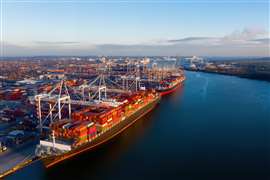UK Labour Party proposes £1.8 billion port infrastructure investment
19 April 2024
Labour leader Keir Starmer was in North England on 18 April to announce what he called the country’s ‘most significant’ investment in port infrastructure in a generation.
 A shipping port in Southampton, Hampshire, England, UK. (Image: Adobe Stock)
A shipping port in Southampton, Hampshire, England, UK. (Image: Adobe Stock)
The allocated £1.8 billion (US$2.2 billion) would come from the party’s Green Prosperity Plan (GPP), which is set to introduce a windfall tax on gas and oil companies to help fund UK enterprises. Labour added that the initiative is meant to help domestic manufacturing across the country.
“This investment will help crowd billions-of-pounds more of private sector investment into UK ports, harbours, and energy industry at our coasts, as part of Labour’s wider plans to end 14 years of industrial decline,” said the party.
Regarding the GPP, Labour said, “The Green Prosperity Plan will help support the creation of up to 650,000 good jobs in Britain’s industrial heartlands, by encouraging billions of private investment into industries such as Britain’s clean energy, steel, automotive, and construction industries.”
The party said it plans to create the National Wealth Fund, which will be the mechanism by which the nearly £2-billion worth of port projects will be funded.
“Labour’s plan will include investments to drive local and economic growth, giving opportunities to plumbers, electricians, welders, and workers in every single nation and region of the country,” it said.
The Conservative Party are currently in power in United Kingdom but the next general election must be held no later than 28 January 2025.





